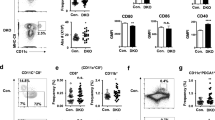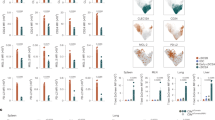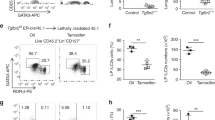Abstract
Dendritic cell (DC) development begins in the bone marrow but is not completed until after immature progenitors reach their sites of residence in lymphoid organs. The hematopoietic growth factors regulating these processes are poorly understood. Here we examined the effects of signaling by the receptor tyrosine kinase Flt3 on macrophage DC progenitors in the bone marrow and on peripheral DCs. We found that the macrophage DC progenitor compartment was responsive to superphysiological amounts of Flt3 ligand but was not dependent on Flt3 for its homeostatic maintenance in vivo. In contrast, Flt3 was essential to the regulation of homeostatic DC development in the spleen, where it was needed to maintain normal numbers of DCs by controlling their division in the periphery.
This is a preview of subscription content, access via your institution
Access options
Subscribe to this journal
Receive 12 print issues and online access
$209.00 per year
only $17.42 per issue
Buy this article
- Purchase on Springer Link
- Instant access to full article PDF
Prices may be subject to local taxes which are calculated during checkout





Similar content being viewed by others
References
Steinman, R.M., Hawiger, D. & Nussenzweig, M.C. Tolerogenic dendritic cells. Annu. Rev. Immunol. 21, 685–711 (2003).
Steinman, R.M. & Banchereau, J. Taking dendritic cells into medicine. Nature 449, 419–426 (2007).
Liu, Y.J. IPC: professional type 1 interferon–producing cells and plasmacytoid dendritic cell precursors. Annu. Rev. Immunol. 23, 275–306 (2005).
Villadangos, J.A. & Schnorrer, P. Intrinsic and cooperative antigen–presenting functions of dendritic–cell subsets in vivo. Nat. Rev. Immunol. 7, 543–555 (2007).
Fogg, D.K. et al. A clonogenic bone marrow progenitor specific for macrophages and dendritic cells. Science 311, 83–87 (2006).
Varol, C. et al. Monocytes give rise to mucosal, but not splenic, conventional dendritic cells. J. Exp. Med. 204, 171–180 (2007).
Onai, N. et al. Identification of clonogenic common Flt3+M-CSFR+ plasmacytoid and conventional dendritic cell progenitors in mouse bone marrow. Nat. Immunol. 8, 1207–1216 (2007).
Naik, S.H. et al. Development of plasmacytoid and conventional dendritic cell subtypes from single precursor cells derived in vitro and in vivo. Nat. Immunol. 8, 1217–1226 (2007).
Liu, K. et al. Origin of dendritic cells in peripheral lymphoid organs of mice. Nat. Immunol. 8, 578–583 (2007).
Kabashima, K. et al. Intrinsic lymphotoxin-β receptor requirement for homeostasis of lymphoid tissue dendritic cells. Immunity 22, 439–450 (2005).
Diao, J., Winter, E., Chen, W., Xu, F. & Cattral, M.S. Antigen transmission by replicating antigen–bearing dendritic cells. J. Immunol. 179, 2713–2721 (2007).
Karsunky, H., Merad, M., Cozzio, A., Weissman, I.L. & Manz, M.G. Flt3 ligand regulates dendritic cell development from Flt3+ lymphoid and myeloid–committed progenitors to Flt3+ dendritic cells in vivo. J. Exp. Med. 198, 305–313 (2003).
Maraskovsky, E. et al. Dramatic increase in the numbers of functionally mature dendritic cells in Flt3 ligand–treated mice: multiple dendritic cell subpopulations identified. J. Exp. Med. 184, 1953–1962 (1996).
Brasel, K. et al. Hematologic effects of flt3 ligand in vivo in mice. Blood 88, 2004–2012 (1996).
Whartenby, K.A. et al. Inhibition of FLT3 signaling targets DCs to ameliorate autoimmune disease. Proc. Natl. Acad. Sci. USA 102, 16741–16746 (2005).
Tussiwand, R., Onai, N., Mazzucchelli, L. & Manz, M.G. Inhibition of natural type I IFN–producing and dendritic cell development by a small molecule receptor tyrosine kinase inhibitor with Flt3 affinity. J. Immunol. 175, 3674–3680 (2005).
Traver, D. et al. Development of CD8α-positive dendritic cells from a common myeloid progenitor. Science 290, 2152–2154 (2000).
D'Amico, A. & Wu, L. The early progenitors of mouse dendritic cells and plasmacytoid predendritic cells are within the bone marrow hemopoietic precursors expressing Flt3. J. Exp. Med. 198, 293–303 (2003).
Wu, L. et al. Development of thymic and splenic dendritic cell populations from different hemopoietic precursors. Blood 98, 3376–3382 (2001).
Dakic, A. et al. Development of the dendritic cell system during mouse ontogeny. J. Immunol. 172, 1018–1027 (2004).
Sun, C.M., Fiette, L., Tanguy, M., Leclerc, C. & Lo-Man, R. Ontogeny and innate properties of neonatal dendritic cells. Blood 102, 585–591 (2003).
Naik, S.H. et al. Intrasplenic steady-state dendritic cell precursors that are distinct from monocytes. Nat. Immunol. 7, 663–671 (2006).
Mackarehtschian, K. et al. Targeted disruption of the flk2fk2/flt3 gene leads to deficiencies in primitive hematopoietic progenitors. Immunity 3, 147–161 (1995).
Ginhoux, F. et al. Langerhans cells arise from monocytes in vivo. Nat. Immunol. 7, 265–273 (2006).
Shigematsu, H. et al. Plasmacytoid dendritic cells activate lymphoid-specific genetic programs irrespective of their cellular origin. Immunity 21, 43–53 (2004).
Christensen, J.L. & Weissman, I.L. Flk-2 is a marker in hematopoietic stem cell differentiation: a simple method to isolate long-term stem cells. Proc. Natl. Acad. Sci. USA 98, 14541–14546 (2001).
Sitnicka, E. et al. Key role of flt3 ligand in regulation of the common lymphoid progenitor but not in maintenance of the hematopoietic stem cell pool. Immunity 17, 463–472 (2002).
Laouar, Y., Welte, T., Fu, X.Y. & Flavell, R.A. STAT3 is required for Flt3L–dependent dendritic cell differentiation. Immunity 19, 903–912 (2003).
McKenna, H.J. et al. Mice lacking flt3 ligand have deficient hematopoiesis affecting hematopoietic progenitor cells, dendritic cells, and natural killer cells. Blood 95, 3489–3497 (2000).
del Hoyo, G.M. et al. Characterization of a common precursor population for dendritic cells. Nature 415, 1043–1047 (2002).
Robb, L. et al. Hematopoietic and lung abnormalities in mice with a null mutation of the common β subunit of the receptors for granulocyte–macrophage colony–stimulating factor and interleukins 3 and 5. Proc. Natl. Acad. Sci. USA 92, 9565–9569 (1995).
Waskow, C., Terszowski, G., Costa, C., Gassmann, M. & Rodewald, H.R. Rescue of lethal c-KitW/W mice by erythropoietin. Blood 104, 1688–1695 (2004).
Herzenberg, L.A., Tung, J., Moore, W.A. & Parks, D.R. Interpreting flow cytometry data: a guide for the perplexed. Nat. Immunol. 7, 681–685 (2006).
Acknowledgements
We thank Amgen for recombinant human Flt3L; I. Lemischka (Mount Sinai School of Medicine) for Flt3−/− mice; L. Robb (Walter and Eliza Hall Institute of Medical Research) and G. Begley (Amgen) for mice deficient in GM-CSF receptor-α; C.G. Park (Rockefeller University) for monoclonal antibodies to CD169 and SIGNR1; R. Steinman and A. Kamphorst for critical reading of the manuscript; and M. Suarez–Farinas for help with statistical analysis.
Author information
Authors and Affiliations
Corresponding author
Supplementary information
Supplementary Text and Figures
Supplementary Figures 1–11 (PDF 673 kb)
Rights and permissions
About this article
Cite this article
Waskow, C., Liu, K., Darrasse-Jèze, G. et al. The receptor tyrosine kinase Flt3 is required for dendritic cell development in peripheral lymphoid tissues. Nat Immunol 9, 676–683 (2008). https://doi.org/10.1038/ni.1615
Received:
Accepted:
Published:
Issue Date:
DOI: https://doi.org/10.1038/ni.1615
This article is cited by
-
Phase I study evaluating the Fc-optimized FLT3 antibody FLYSYN in AML patients with measurable residual disease
Journal of Hematology & Oncology (2023)
-
Expanding cross-presenting dendritic cells enhances oncolytic virotherapy and is critical for long-term anti-tumor immunity
Nature Communications (2022)
-
Dendritic cells play no significant role in the laser-induced choroidal neovascularization model
Scientific Reports (2021)
-
Tcf1 and Lef1 provide constant supervision to mature CD8+ T cell identity and function by organizing genomic architecture
Nature Communications (2021)
-
Transforming growth factor β as a possible independent factor in chronic hepatitis B
Archives of Virology (2021)



